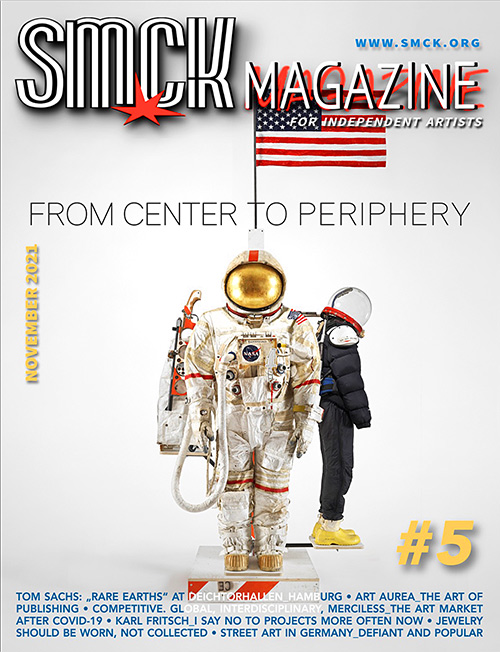I SAY NO TO PROJECTS MORE OFTEN NOW
KARL FRITSCH ON THE CHALLENGES HIS LIFE IN NEW ZEALAND OFFERS.
Interview by Christoph Ziegler
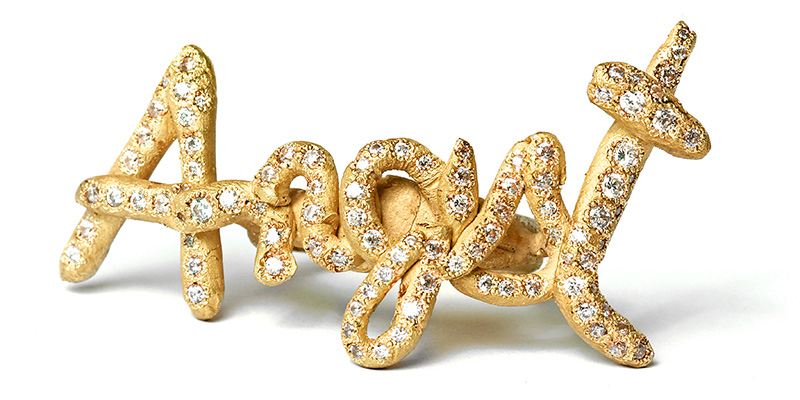 Ring, 2021. Gold, diamond imitation. Courtesy Fingers gallery, New Zealand.
Ring, 2021. Gold, diamond imitation. Courtesy Fingers gallery, New Zealand.
CZ: Describe a typical day in your studio.
KF: Before I go to the studio I usually walk the dogs - one mongrel mix, medium-size, brindle-colored boy and one inherited fluffy, white Japanese Spitz. Then I usually do a Tai Chi set in the garden.
When there are no urgent emails to answer I go to the workshop and do what feels most appealing. Sometimes before exhibitions there are rings and things that need to be finished.
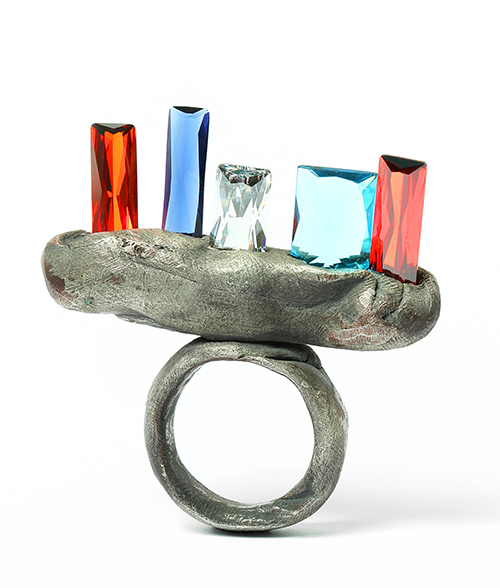
Ring, 2020. silver, imitation sapphire, cubic zirconia. Courtesy Galerie Zink, Germany.
But my most favorite state is when there is nothing urgent and I engage with whatever I am most excited about. At the moment I am very excited about making lamps with the kelp that gets washed up on the beach after a storm.
But generally, there are hundreds of rings in different stages of manufacture that wait for attention.
I have also been making some pottery lately. Once the workshop mode takes over, it is open until the evening.
CZ: What inspires your work?
KF: The main driver is still my jewelry past - techniques I learned during my apprenticeship and studies. I revisit them, I twist and adapt them as much as they allow me - and I allow myself - to do.
Here in New Zealand some common local techniques like stone-carving have entered my practice and I research different ways of using stones in my jewelry. The kelp lamps are another example of how a material that is simply around me enters my work.
CZ: Your jewelry can be found in more than 30 public collections worldwide and you work with 15 galleries in New Zealand and abroad. How do you cope with the pressure of producing such a quantity of work to keep galleries, museums, and exhibition curators satisfied?
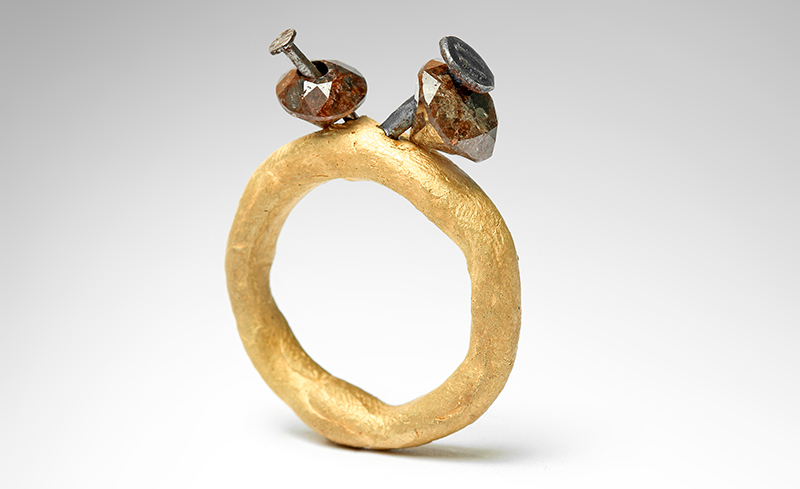 Ring, 2020. Gold, diamonds, nails. Courtesy Galerie Zink, Germany.
Ring, 2020. Gold, diamonds, nails. Courtesy Galerie Zink, Germany.
KF: Ha ha, good question! Generally, I really like working. Also, once a museum has bought for their collection, it is usually a long time before they might come back for more.
I admit that I did hit a wall about five years ago when I was not able to work because of a back injury. It felt like my whole world collapsed and the pressure was immense. Because of that, I am watching that balance more closely nowadays and say no to projects more often than before. Sometimes it is also fascinating what you can do and come up with when there is a bit of pressure on.
CZ: You started your career in Munich, a center for contemporary jewelry in Europe. What, in your opinion, are the cultural differences between Europe and New Zealand?
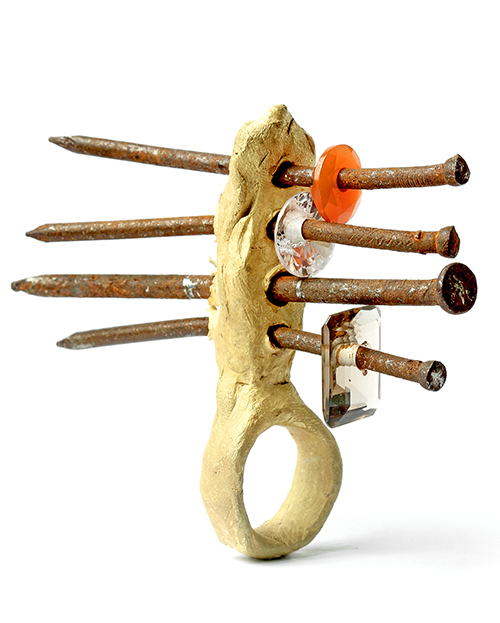
Ring, 2021. Gold, nails, smokey quartz, carnelian, chrystal. Courtesy The National gallery, New Zealand.
KF: I grew up in the Allgäu mountains. Now I live close to the sea with nothing but water between our Island Bay beach and Antarctica. Nature is very powerful here; I love it. There are new outdoor activities like surfing and diving on the menu. It's been a challenging new learning curve.
The population is not very dense and people seem generally a bit more relaxed and friendly here.
CZ: What role does contemporary jewelry play in the cultural life of Wellington?
KF: It is quite a lively scene. Sadly the only institution where you could study jewelry-making closed its jewelry department last year.
There are some great self-taught jewelers here, though, who put contemporary jewelry on the map many years ago, such as the founding members of Fingers Gallery. I really like that kind of pioneer mentality that you do not desperately need an institution to become a professional jeweler.
CZ: How would you describe jewelry lovers in New Zealand?
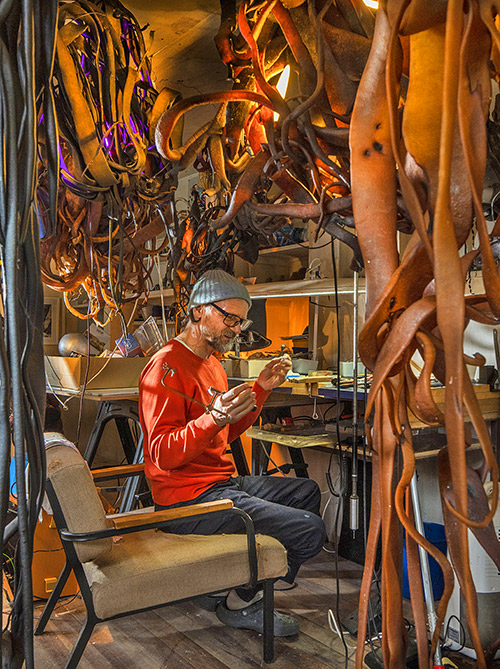
Karl Fritsch in his studio in Wellington, surrounded by his kelp lamps.
KF: Bloody amazing!
CZ: Together with your partner in art and life, Lisa Walker, you are active in New Zealand's jewelry community. Tell us about your activities.
KF: We are part of a mentorship project called HandShake, which gives upcoming jewelers a chance to have an exchange with an established artist.
We did a residency at Driving Creek Pottery, where artists meet and make work together in an amazing piece of regenerated New Zealand bush on the Coromandel Peninsula. This was the vision of Barry Brickel, a potter who then left it to a Trust to keep this creative paradise going.
CZ: What needs to be done to increase the general public's interest in contemporary jewelry?
KF: Make the best work you can!
Homepage:
www.karlfritsch.com








